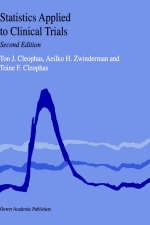
Statistics Applied to Clinical Trials
Kluwer Academic Publishers (Verlag)
978-1-4020-0569-5 (ISBN)
- Lieferbar
- Versandkostenfrei
- Auch auf Rechnung
- Artikel merken
In 1848 the first randomized controlled trial was published by the English Medical Research Council in the "British Medical Journal". Until then, observations had been uncontrolled. Initially, trials frequently did not confirm hypotheses to be tested. This phenomenon was attributed to low sensitivity due to small samples, as well as inappropriate hypotheses based on biased prior trials. Additional flaws were recognized and subsequently were better accounted for: carry-over effects due to insufficient washout from previous treatments, time effects due to external factors and the natural history of the condition under study, bias due to asymmetry between treatment groups, lack of sensitivity due to a negative correlation between treatment responses, and so on. Such flaws, mainly of a technical nature, have been largely corrected and led to trials after 1970 being of significantly better quality than before. The past decade has focused, in addition to technical aspects, on the need for circumspection in planning and conducting of clinical trials.
As a consequence, prior to approval, clinical trial protocols are now routinely scrutinized by different circumstantial bodies, including ethics committees, institutional and federal review boards, national and international scientific organizations, and monitoring committees charged with conducting interim analyses. This book not only explains classical statistical analyses of clinical trials, but addresses relatively novel issues, including equivalence testing, interim analyses, sequential analyses, and meta-analyses, and provides a framework of the best statistical methods available for such purposes.
Preface. Foreword. 1. Hypotheses, Data, Stratification. 2. The analysis of efficacy data of drug trials. 3. The analysis of safety data of drug trials. 4. Equivalence testing. 5. Statistical power and sample size. 6. Interim analysis. 7. Multiple statistical inferences. 8. Principles of linear regression. 9. Subgroup analysis multiple linear regression: confounding, interaction, synergism. 10. Curvilinear regression. 11. Meta-analysis. 12. Crossover studies with continuous variables: power analysis. 13. Crossover studies with binary responses. 14. Post-hoc analysis in clinical trials, a case for logistic regression analysis. 15. quality-of-life assessment in clinical trials. 16. Statistics for the analysis of genetic data. 17. Relationship among statistical distributions. 18. Statistics is not "bloodless" algebra. Appendix. Index.
| Zusatzinfo | index |
|---|---|
| Sprache | englisch |
| Maße | 156 x 234 mm |
| Gewicht | 500 g |
| Themenwelt | Medizin / Pharmazie ► Medizinische Fachgebiete ► Pharmakologie / Pharmakotherapie |
| Studium ► Querschnittsbereiche ► Epidemiologie / Med. Biometrie | |
| ISBN-10 | 1-4020-0569-5 / 1402005695 |
| ISBN-13 | 978-1-4020-0569-5 / 9781402005695 |
| Zustand | Neuware |
| Haben Sie eine Frage zum Produkt? |
aus dem Bereich


